Top Reasons Malaysia Industries Choose Pallet Inverters for GMP Compliance and Labor-Saving Automation
Are your operational costs rising while a skilled labor shortage squeezes your production? You try to maintain the highest standards, especially for GMP (Good Manufacturing Practice) compliance, but manual processes are slow, risky, and prone to error. In Malaysia’s competitive industrial landscape, falling behind on efficiency or compliance isn't an option. It feels like you're constantly fighting fires—product damage from manual handling, potential contamination, and workplace injuries—all of which eat into your profits and reputation.
The key reasons Malaysian industries are adopting pallet inverters are for their dual ability to ensure strict GMP compliance and deliver significant labor-saving automation. Pallet inverters achieve this by automating the process of transferring goods from one pallet to another. This eliminates manual handling, which is a major source of contamination and product damage. It also frees up workers for more valuable tasks, directly addressing labor shortages and reducing operational costs. For industries like food, beverage, and pharmaceuticals in Malaysia, this technology is a direct solution to their biggest operational headaches.
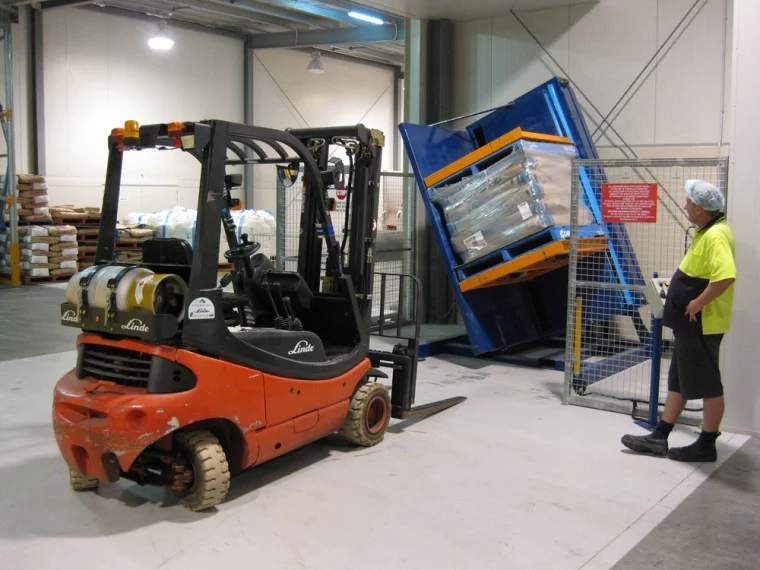
I've seen this transformation happen many times. I'm Vincent Liu, and I've spent my entire career in the packing machine industry. I started on the factory floor and eventually built my own company, SHJLPACK. I understand the pressure you're under. You need solutions that work, deliver a clear return on investment, and make your life easier. Pallet inverters are one of those solutions. They are not just a piece of equipment; they are a strategic tool for modernization. Let’s explore exactly how they solve these critical challenges for businesses just like yours.
How do pallet inverters achieve GMP compliance in regulated industries?
Your products are on the line, and so is your reputation. In sectors like pharmaceuticals and food manufacturing, a single contamination event can lead to massive recalls, regulatory fines, and a loss of customer trust. The pressure to maintain a sterile, controlled environment is immense. You worry that your standard wooden pallets, necessary for shipping, are introducing contaminants like dust, pests, and bacteria into your clean production areas. This constant battle between logistical needs and hygiene standards is a major source of stress.
A pallet inverter is the definitive solution for enforcing GMP by creating a perfect barrier between external and internal logistics. It allows you to transfer your finished goods from in-house, hygienic plastic or aluminum pallets to standard wooden shipping pallets right at the edge of your cleanroom or dispatch area. This single, automated action eliminates the need for contaminated wooden pallets to ever enter your sensitive production zones. It also prevents product damage and the ergonomic risks associated with manually restacking heavy loads, further cementing your commitment to GMP standards.
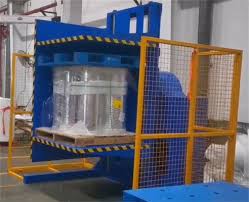
Dive Deeper: Breaking Down GMP and Pallet Inverter Synergy
To truly understand the value, we need to look at specific GMP principles and how a pallet inverter directly addresses them. GMP is not just a suggestion; it's a system of control and management for manufacturing. Let's break it down.
Cross-Contamination Control
This is the most obvious and critical benefit. GMP mandates that all necessary measures be taken to prevent contamination of a product. Wooden pallets are porous. They absorb moisture, harbor insects, and collect dirt from warehouses and trucks. Bringing them into a food or pharmaceutical production hall is a direct violation of the spirit, if not the letter, of GMP.
A pallet inverter acts as a gatekeeper. Your internal process uses only sanitized, non-porous pallets (like plastic or steel). When the product is ready for shipment, it's moved to the inverter. The machine securely clamps the load, rotates it, and allows the clean pallet to be removed from the top. Then, a shipping pallet is placed on the load, and the machine rotates back. The entire process takes about a minute and happens in a designated "gray area," physically separating your clean zone from your logistics zone.
Process Validation and Consistency
GMP requires processes to be validated to ensure they consistently produce a result meeting pre-determined specifications. Manual pallet changing is anything but consistent. Different teams or individuals will perform the task differently. Some might be careful, others might be rushed. This inconsistency can lead to dropped boxes, damaged packaging, and even personal injury.
An automated pallet inverter performs the exact same action, with the same pressure and speed, every single time. The process is repeatable, predictable, and therefore, validatable. You can set the clamping pressure to match your product's fragility, ensuring that from the first pallet of the day to the last, the handling procedure is identical and safe. This mechanical consistency is something manual labor can never guarantee.
Documentation and Traceability
While the machine itself doesn't create paperwork, its use simplifies documentation. Your SOP (Standard Operating Procedure) for pallet exchange becomes incredibly simple: "All finished goods must be transferred from blue plastic pallets to wooden shipping pallets using Pallet Inverter #1 located at dispatch door 4." This is much easier to audit and enforce than a complex, multi-step manual handling procedure. Modern inverters can also be integrated with MES (Manufacturing Execution Systems) to log every cycle, linking a specific pallet load to a time, date, and operator, enhancing traceability.
| GMP Requirement | Manual Pallet Change (The Problem) | Pallet Inverter (The Solution) |
|---|---|---|
| Contamination Prevention | Wooden pallets enter clean areas. High risk of dust, pests, bacteria. | Creates a physical barrier. Wooden pallets never enter sensitive zones. |
| Product Integrity | High risk of dropping, crushing, or damaging goods during restacking. | Securely clamps and rotates the entire load. Zero manual handling of individual items. |
| Process Consistency | Varies by employee. Unpredictable and hard to validate. | 100% repeatable, automated cycle. Consistent and validatable process. |
| Worker Safety (Ergonomics) | Repetitive lifting, bending, and twisting. High risk of musculoskeletal injuries. | Eliminates all manual lifting of the load. Operator uses simple controls. |
I once worked with a pharmaceutical company in Malaysia that was constantly getting cited by auditors for pallet-related issues. They tried everything: pallet sanitizing stations, covering wooden pallets, dedicated "clean" forklifts. It was an operational nightmare. After installing a simple, freestanding pallet inverter, their next audit was clean. The auditor was impressed, not just by the machine, but by the simplicity and robustness of the new procedure it enabled. That's the power of targeting the root cause.
What are the real labor-saving benefits of automating with pallet inverters?
You see your team struggling. Manually destacking and restacking a full pallet of goods is back-breaking work. It’s slow, it’s physically demanding, and it’s a recipe for workplace injuries, leading to downtime and compensation claims. Furthermore, finding reliable workers for such physically strenuous tasks is getting harder and more expensive in Malaysia. You're paying a team of two or three people to spend hours doing a low-value, high-risk job that adds nothing to the quality of your product. This is a direct drain on your resources.
Pallet inverters provide immediate and measurable labor-saving benefits by transforming a multi-person, 20-minute task into a one-person, 60-second operation. The automation completely eliminates the need for manual lifting. This not only prevents costly injuries but also frees up your valuable employees. They can now be retrained and redeployed to more skilled, value-added roles like quality control, machine operation, or inventory management, significantly boosting your overall productivity and reducing your reliance on manual labor.
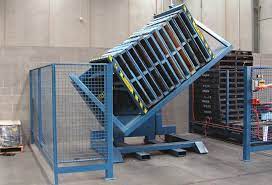
Dive Deeper: Quantifying the Savings and Boosting Productivity
Let's move beyond the general concept of "saving labor" and look at the hard numbers. As a factory owner myself, I know that investments must be justified with a clear return. The business case for a pallet inverter is one of the easiest to make.
Direct Labor Cost Reduction
Consider a typical scenario:
- Manual Method: Two workers are needed to manually transfer a load from one pallet to another. Let's say the load consists of 50 boxes. It takes them approximately 20 minutes from start to finish.
- Automated Method: One worker operates the pallet inverter. The entire cycle—loading, inverting, exchanging the pallet, and unloading—takes about 1-2 minutes.
Let's do some simple math. Assume you need to swap 15 pallets per day.
- Manual: 15 pallets x 20 minutes/pallet = 300 minutes (5 hours) of labor for two people. That's 10 man-hours per day.
- Automated: 15 pallets x 2 minutes/pallet = 30 minutes of labor for one person. That's 0.5 man-hours per day.
You have just saved 9.5 man-hours every single day. In Malaysia, with an average manufacturing labor wage, this saving alone can often lead to a full return on the investment in the pallet inverter in less than 18 months. This calculation doesn't even include overtime, benefits, or the cost of hiring and training.
Indirect Savings and Productivity Gains
The direct labor savings are just the beginning. The indirect benefits create an even more compelling case.
-
Elimination of Product Damage: Every time a box is handled manually, there's a risk of it being dropped, dented, or punctured. A pallet inverter handles the entire load as a single, stable block. If you are currently writing off even 1% of your product due to handling damage, eliminating this loss goes directly to your bottom line. For a client in the beverage industry, this was a huge factor. They were losing several bottles per pallet swap, and the cost of cleanup was almost as high as the cost of the lost product. The inverter paid for itself in damage prevention alone.
-
Reduction in Workplace Injuries: Musculoskeletal disorders from repetitive lifting are one of the leading causes of workplace injury claims. These claims are expensive, involving medical costs, lost workdays, and potentially higher insurance premiums. A pallet inverter removes this risk entirely. A healthier workforce is a more productive and reliable workforce.
-
Increased Throughput: The speed of the automated process means you can handle more volume in less time. If your business is growing, a manual pallet-swapping station can quickly become a bottleneck that chokes your entire production line. A pallet inverter ensures your dispatch area can keep pace with production, getting your products out the door faster.
| Metric | Manual Process (Before Inverter) | Automated Process (With Inverter) | Impact |
|---|---|---|---|
| Time per Pallet | ~20 minutes | ~2 minutes | 90% Time Reduction |
| Labor Required | 2-3 Workers | 1 Operator | 50-67% Staff Reduction |
| Risk of Injury | High (lifting, bending) | Near Zero | Improved Worker Safety |
| Risk of Damage | Moderate to High | Very Low | Reduced Spoilage Costs |
| Process Bottleneck | Common at high volumes | Eliminated | Increased Throughput |
By automating this single task, you are not just replacing manual labor. You are fundamentally improving the safety, speed, and efficiency of your entire logistics workflow. You are reallocating your most important asset—your people—from a dangerous, repetitive task to roles where their skills and judgment can actually help grow your business.
Can pallet inverters integrate with both old equipment and new digital systems?
Your factory is a mix of the old and the new. You have reliable production lines that have been running for over a decade, but you are also pushing for a digital transformation with MES and IoT. You worry that any new equipment will be difficult to integrate. Will it be a standalone "island of automation" that doesn't talk to your other systems? Or will it require a complete and costly overhaul of your existing layout? This uncertainty can paralyze investment decisions, leaving you stuck with inefficient manual processes.
Pallet inverters are designed for versatility and can be seamlessly integrated into almost any factory environment, old or new. For older production lines, a simple, freestanding 180-degree inverter can be placed at the end of a line, operated by a forklift driver with simple push-button controls. For modern, fully automated facilities, inverters can be equipped with PLCs, safety sensors, and light curtains, and integrated directly into conveyor systems. They can receive commands from your MES, providing a bridge between your legacy equipment and your digital future.
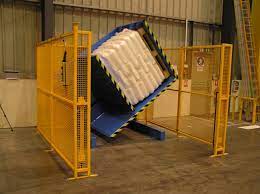
Dive Deeper: Bridging the Gap Between Legacy and Automation
As an engineer, I love the practical elegance of pallet inverters because they solve this exact problem. They are a modular solution that can grow with your company's technological journey. Let's look at the specific integration pathways.
Pathway 1: The Standalone Workhorse for Legacy Lines
This is the most common starting point for many industries in Malaysia. You have an existing production line that ends with a pallet wrapper. Currently, a forklift takes the wrapped pallet to a staging area where it is manually re-stacked for shipping or onto a clean pallet for warehouse storage.
- The Solution: A freestanding pallet inverter is installed in that staging area. It requires only a power connection and a solid, level floor.
- The Workflow:
- A forklift brings the source pallet (e.g., a wooden pallet) and places it into the inverter.
- The operator uses a simple remote control or attached console to clamp the load and rotate it 180 degrees.
- The forklift removes the original pallet (which is now on top) and replaces it with the destination pallet (e.g., a plastic pallet).
- The operator rotates the load back, and the forklift removes the newly palletized product.
- Integration Level: Minimal. This method does not require any changes to your existing production line. It is a simple, robust, and highly effective way to automate a single, problematic manual task. It's a quick win with a fast ROI.
Pathway 2: The Semi-Automated, Conveyor-Fed System
Perhaps you have some level of automation, like powered conveyors leading from your case packers or palletizers.
- The Solution: An in-line pallet inverter is used. This model is designed with a floor-level base so that pallets can be fed in and out via a conveyor or even a simple pallet jack.
- The Workflow:
- The pallet moves down a conveyor and stops at the inverter's entrance.
- An operator, or an automated sensor, initiates the clamping and inverting cycle.
- The system pauses to allow for the pallet exchange, which can still be done by a forklift or an automated pallet dispenser/stacker.
- The machine rotates back and discharges the pallet onto an outbound conveyor.
- Integration Level: Medium. This requires some PLC handshaking ("I'm ready," "Cycle complete") between the inverter and the conveyors. It connects islands of automation and smooths the flow of goods significantly.
Pathway 3: The Fully Integrated "Lights-Out" Solution
This is for the cutting-edge factory aiming for full digitalization, like the ones Javier Morales dreams of building.
- The Solution: A fully automated pallet inverter system, complete with automated pallet dispensers, stackers, safety fencing, and light curtains.
- The Workflow:
- The MES/WMS (Warehouse Management System) directs a pallet to the transfer station.
- It is fed via an AGV (Automated Guided Vehicle) or conveyor into the fully guarded inverter cell.
- The inverter's PLC communicates with the central control system, receives the correct recipe (e.g., clamping pressure for this specific SKU), and performs the exchange cycle.
- An automated pallet dispenser feeds the new pallet, and a stacker removes the old one. No human intervention is needed.
- The system logs the completed task back to the MES.
- Integration Level: High. This is a key component of a smart factory, enabling full traceability and hands-free operation.
The beauty of this technology is that you can start with Pathway 1 today and have a clear upgrade path to Pathway 3 tomorrow without replacing the core inverter itself. The machine can be adapted with new controls and peripherals as your factory evolves. It's a future-proof investment.
What is the true ROI of a pallet inverter for a Malaysian manufacturing plant?
As a business owner, you look at every potential purchase through the lens of cost versus benefit. You hear the promises of GMP compliance and labor savings, but you need to see the numbers. How long will it take for this machine to pay for itself? You are under pressure to reduce operational costs and increase profit margins. An investment that doesn't deliver a clear, calculable financial return is a non-starter, no matter how technologically advanced it is.
The true Return on Investment (ROI) for a pallet inverter in a Malaysian context is typically achieved within 12 to 24 months, based on a combination of direct and indirect financial gains. The calculation goes beyond simple labor savings. It must include the quantifiable cost of product damaged during manual handling, the reduction in injury-related expenses, increased throughput, and the avoidance of potentially huge fines or business loss from GMP non-compliance. When all these factors are considered, the pallet inverter proves to be a powerful profit-generating asset.
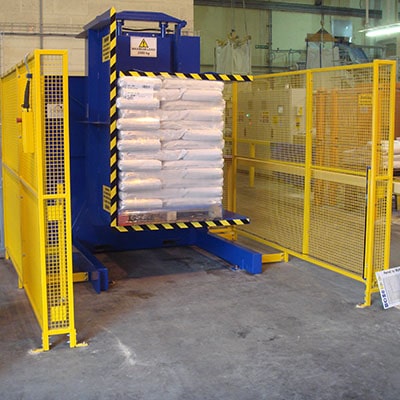
Dive Deeper: A Practical ROI Calculation
Let's build a sample ROI case for a mid-sized food manufacturer in Malaysia. I encourage you to substitute these figures with your own to see the real potential.
Assumptions:
- Cost of a standard, freestanding pallet inverter (including delivery and installation): RM 80,000
- Number of pallets exchanged per day: 20
- Manual exchange team: 2 workers
- Time per manual exchange: 15 minutes
- Average hourly wage (including all costs): RM 15/hour
- Product damage rate from manual handling: 0.5% of value
- Value of goods per pallet: RM 4,000
- Operating days per year: 250
1. Calculating the Annual Savings
Let's break down the savings into clear categories.
A. Direct Labor Savings:
- Total manual time per day: 20 pallets * 15 min/pallet = 300 minutes = 5 hours
- Total manual labor cost per day: 5 hours 2 workers RM 15/hour = RM 150
- Automated time per day (1 operator, 2 min/pallet): 20 pallets * 2 min = 40 minutes ≈ 0.67 hours
- Automated labor cost per day: 0.67 hours 1 worker RM 15/hour = RM 10
- Daily Labor Saving: RM 150 - RM 10 = RM 140
- *Annual Labor Saving: RM 140 250 days = RM 35,000**
B. Reduced Product Damage Savings:
- Total value of goods handled per day: 20 pallets * RM 4,000/pallet = RM 80,000
- Cost of damage per day (manual): RM 80,000 * 0.5% = RM 400
- With an inverter, this damage is virtually eliminated.
- *Annual Damage Saving: RM 400 250 days = RM 100,000**
I know this number looks high, but from my experience, it's realistic. I had a client in the electronics sector who was shocked when they calculated their "minor" damage costs. A few cracked casings and damaged circuit boards on each pallet added up to a massive annual loss. The inverter eliminated this completely.
C. Intangible, but Real, Savings:
These are harder to quantify but are critically important.
- Injury Prevention: The cost of one serious back injury claim can easily exceed RM 20,000 in medical bills and lost time. We'll use a conservative estimate for savings. Annualized Estimated Saving: RM 5,000
- GMP Compliance: The cost of a product recall or a major regulatory fine can be catastrophic. The value of avoiding this is immense. We can conservatively value the 'insurance' provided by the machine. Annualized Estimated Saving: RM 10,000
2. Calculating the ROI
| Savings Category | Annual Savings (RM) |
|---|---|
| Direct Labor | 35,000 |
| Reduced Product Damage | 100,000 |
| Injury Prevention (Est.) | 5,000 |
| GMP Compliance (Est.) | 10,000 |
| Total Annual Savings | RM 150,000 |
- Initial Investment: RM 80,000
- Total Annual Savings: RM 150,000
Payback Period = Initial Investment / Total Annual Savings
Payback Period = 80,000 / 150,000 = 0.53 years, or approximately 6.4 months.
In this very realistic scenario, the machine pays for itself in just over half a year. After that, it contributes RM 150,000 in savings and recovered revenue directly to your profit margin every single year. When you present a business case like this, based on your own data, the decision becomes clear. It's not an expense; it's one of the most profitable investments you can make in your facility.
My Insights
I remember meeting a steel mill owner, a man very much like Javier Morales. He was tough, pragmatic, and had built his business from the ground up. He saw every machine not as a tool, but as an employee that had to earn its keep. When we first talked about equipment for his coil packing line, he was skeptical about automation. His argument was, "I have good people. Why do I need an expensive machine to do what they already do?"
I didn't try to sell him a machine. Instead, I asked him to walk the factory floor with me. We watched his team wrap heavy steel coils. We saw the strain in their backs. We saw how one small mistake in banding could lead to a coil telescoping during transit, costing thousands. We timed the process. It was effective, but it was slow and it was risky. His "good people" were being put in a bad position, every single day.
That conversation changed his perspective. He started seeing the machine not as a replacement for his people, but as a tool to protect them and make them more effective. He realized that by automating the dangerous, repetitive parts of the job, he could move his best people into supervisory and quality control roles—jobs that used their brains, not just their bodies. This is the same principle that applies to pallet inverters.
Too many business owners in Malaysia and around the world see a pallet inverter and think, "That's a machine to flip pallets." But that's missing the point entirely.
You are not buying a pallet flipper. You are buying:
- Consistency: Every product is handled the same way, every time.
- Safety: You are eliminating a major cause of workplace injuries.
- Compliance: You are building a foolproof system to meet GMP and other quality standards.
- Speed: You are removing a bottleneck and increasing your plant's overall capacity.
- Opportunity: You are freeing your employees to do more valuable work.
My journey from being an engineer on the factory floor to owning my own business has taught me one crucial lesson: the best investments are the ones that solve multiple problems at once. A pallet inverter doesn't just solve a logistics problem. It solves a safety problem, a quality problem, and a human resources problem. It is a strategic investment in the long-term health and profitability of your business. That's why industries in Malaysia are choosing them, and it's why you should seriously consider one too.
Conclusion
In short, pallet inverters offer Malaysian industries a powerful, multi-faceted solution for GMP compliance, labor automation, and a rapid return on investment, securing a competitive edge in a demanding market.



